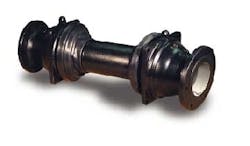Flexible Joint Stands Up to Pipe Movement
The Romac Industries FlexiJoint is a flexible, ductile iron joint developed to accommodate pipeline movement that could result in damage or loss of service. The joint accommodates expansion, contraction and bending, plus provides restraint for pipes. They are available with flanged or Mechanical Joint style ends. Sizes range from 3" to 24".
The casing of the FlexiJoint is one piece and requires no threaded fasteners for assembly. Fasteners create places where corrosion first strikes. By eliminating this, the joints increase corrosion resistance and decrease the chances for a leak or break. This design feature also eliminates flanged assembly connections. The resulting monolithic casing construction achieves restraint capabilities of 8.4 tons of force for all sizes.
A single FlexiJoint ball end is able to provide a bending angle of up to ±15° to ±20° (depending on size). This corresponds to a total bending angle of ±30° to ±40°. By varying the length of the sleeve, the joints will also accommodate lateral offset of 4 to 20". When special conditions demand, a FlexiJoint of 3 to 12" in size can accommodate an additional bending angle.
The design of the joints will allow rotation or torsion of the pipeline components. This freedom of movement prevents damage to flanges, valves and other structures associated with the pipeline. The joints allow this movement while still accommodating bending and offset of the pipeline.
FlexiJoint components, including the stainless steel lock ring, are lined and coated with fusion bonded epoxy powder, meeting the requirements of AWWA C213. Each component of the joint is holiday tested. This coating provides corrosion resistance and meets the requirements of NSF Standard 61.
The seals of the joints are specially molded rubber gaskets. The gaskets are used in the casing to allow deflection and in the ball to allow expansion and contraction. A casing cover is provided to assure contamination free operation.
The FlexiJoint was designed for use in a diverse range of critical applications such as pipe installations leading into and out of a valve box, pipe installations surrounding a structure, across a boundary of earth layer, road crossings, under a river, around an emergency reservoir tank, and in most earthquake prone areas.
Throughout development and production, the FlexiJoint has been subjected to numerous tests. The most notable tests include the following:
- Horizontal pressure in straight and offset conditions - The joints were installed in horizontal, straight and offset installations, then pressurized and inspected for water leaks or other abnormal indications.
- Cycle testing of expansion and offset - The joints were installed into test equipment and pressurized under repeated expansion, contraction, and offset conditions.
- Restraining force - The joints were installed in a test apparatus that applied a tensile load equivalent to 16,800 lbs. at the ends.
- Water flow characteristics - A clear acrylic FlexiJoint was used so testers could observe water flow to confirm that no water stagnation occurred inside of the joint at straight and deflected conditions.
- Earthquake resistance - To test the joint's ability to withstand earthquakes, test equipment reproduced the effect of discontinuous earth, for example a boundary earth layer and connecting components between structures. The joints also underwent a shaking test to approximate the conditions of the Great Hanshin-Awaji Earthquake, which produced accelerations over 818 cm/s.

